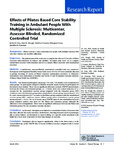Effects of Pilates-Based Core Stability Training in Ambulant People With Multiple Sclerosis: Multicenter, Assessor-Blinded, Randomized Controlled Trial
| dc.contributor.author | Fox, EE | |
| dc.contributor.author | Hough, AD | |
| dc.contributor.author | Creanor, Siobhan | |
| dc.contributor.author | Gear, M | |
| dc.contributor.author | Freeman, Jennifer | |
| dc.date.accessioned | 2016-12-06T17:07:44Z | |
| dc.date.accessioned | 2016-12-07T10:22:57Z | |
| dc.date.available | 2016-12-06T17:07:44Z | |
| dc.date.available | 2016-12-07T10:22:57Z | |
| dc.date.issued | 2016-08 | |
| dc.identifier.issn | 0031-9023 | |
| dc.identifier.issn | 1538-6724 | |
| dc.identifier.uri | http://hdl.handle.net/10026.1/8077 | |
| dc.description.abstract |
Background Pilates exercise is often undertaken by people with multiple sclerosis (MS) who have balance and mobility difficulties. Objectives The primary aim of the study was to compare the effects of 12 weeks of Pilates exercises with relaxation on balance and mobility. Secondary aims were: (1) to compare standardized exercises with relaxation and (2) to compare Pilates exercises with standardized exercises. Methods A multicenter, assessor-blinded, randomized controlled trial was conducted. Participants with Expanded Disability Status Scale scores of 4.0 to 6.5 were randomly allocated to groups receiving 12 weeks of Pilates exercises, standardized exercises, or relaxation. Assessments were undertaken at baseline and weeks 12 and 16 (primary outcome measure: 10-Meter Timed Walk Test [10MTW]). Results One hundred participants (mean age=54 years, 74% female) were randomized to study groups. Six participants relapsed (withdrew from the study), leaving 94 participants for intention-to-treat analysis. There was no significant difference in mean 10MTW measurements between the Pilates and relaxation groups. At 12 weeks, there was a mean reduction of 4.2 seconds for the standardized exercise group compared with the relaxation group (95% confidence interval [relaxation group minus standardized exercise group measurements]=0.0, 8.4) and a mean reduction of 3.7 seconds for the Pilates group compared with the standardized exercise group (95% confidence interval [Pilates group minus standardized exercise group measurements]=−0.4 to 7.8). At 16 weeks, mean 10MTW times for the standardized exercise group remained quicker than those for the Pilates and relaxation groups, although the differences were nonsignificant. There were no significant differences between the Pilates and relaxation groups for any secondary outcome measure. Limitations In this study, therapists were limited to a standardized basket of exercises that may have affected the study outcomes. Furthermore, choosing measures such as posturography to assess balance, accelerometry to assess walking, or a specific trunk assessment scale might have been more responsive in detecting changes in outcome. Conclusion Participants did not improve significantly, either in the short term or at the 4-week follow-up, on the 10MTW after 12 weeks of Pilates exercises compared with 12 weeks of relaxation. | |
| dc.format.extent | 1170-1178 | |
| dc.language.iso | en | |
| dc.relation.replaces | http://hdl.handle.net/10026.1/8075 | |
| dc.relation.replaces | 10026.1/8075 | |
| dc.title | Effects of Pilates-Based Core Stability Training in Ambulant People With Multiple Sclerosis: Multicenter, Assessor-Blinded, Randomized Controlled Trial | |
| dc.type | journal-article | |
| plymouth.author-url | http://gateway.webofknowledge.com/gateway/Gateway.cgi?GWVersion=2&SrcApp=PARTNER_APP&SrcAuth=LinksAMR&KeyUT=WOS:000386165800007&DestLinkType=FullRecord&DestApp=ALL_WOS&UsrCustomerID=11bb513d99f797142bcfeffcc58ea008 | |
| plymouth.issue | 8 | |
| plymouth.volume | 96 | |
| plymouth.publication-status | Published | |
| plymouth.journal | PHYSICAL THERAPY | |
| dc.identifier.doi | 10.2522/ptj.20150166 | |
| plymouth.organisational-group | /Plymouth | |
| plymouth.organisational-group | /Plymouth/Faculty of Health | |
| plymouth.organisational-group | /Plymouth/Faculty of Health/School of Health Professions | |
| plymouth.organisational-group | /Plymouth/REF 2021 Researchers by UoA | |
| plymouth.organisational-group | /Plymouth/REF 2021 Researchers by UoA/UoA03 Allied Health Professions, Dentistry, Nursing and Pharmacy | |
| plymouth.organisational-group | /Plymouth/Research Groups | |
| plymouth.organisational-group | /Plymouth/Research Groups/Institute of Health and Community | |
| plymouth.organisational-group | /Plymouth/Research Groups/Institute of Translational and Stratified Medicine (ITSMED) | |
| plymouth.organisational-group | /Plymouth/Research Groups/Institute of Translational and Stratified Medicine (ITSMED)/CBBB | |
| plymouth.organisational-group | /Plymouth/Research Groups/Plymouth Institute of Health and Care Research (PIHR) | |
| plymouth.organisational-group | /Plymouth/Users by role | |
| plymouth.organisational-group | /Plymouth/Users by role/Academics | |
| plymouth.organisational-group | /Plymouth/Users by role/Researchers in ResearchFish submission | |
| dcterms.dateAccepted | 2016-01-25 | |
| dc.identifier.eissn | 1538-6724 | |
| dc.rights.embargoperiod | Not known | |
| rioxxterms.versionofrecord | 10.2522/ptj.20150166 | |
| rioxxterms.licenseref.uri | http://www.rioxx.net/licenses/all-rights-reserved | |
| rioxxterms.licenseref.startdate | 2016-08 | |
| rioxxterms.type | Journal Article/Review | |
| plymouth.oa-location | http://dx.doi.org/10.2522/ptj.20150166 |


